SCIENTISTS are working to develop robotic principles that could help the meat processing sector boost its global competitiveness – with the help of an unlikely recruit.
Originally from Bath in the United Kingdom, Professor Peter Brett has had an esteemed career over the past 30 years in surgical robotics and was part of the team that developed robotics able to automatically place a cochlear implant in the inner ear.

Professor Peter Brett
“It was the first surgical robot of its kind, interacting with human tissue in a way to minimise disturbance within the hearing organ,” Professor Brett said.
“For a long time in the medical field, we were focused on how to use interactive robots in non-rigid tissues. Now there’s a focus on addressing the natural environment and mediums in a deeper way by developing robotics able to respond to the normal types of inconsistency expected,” he said.
As a natural medium with high inconsistencies, red meat is an ideal agent for Professor Brett to apply his knowledge to.
When the University of Southern Queensland’s Centre for Agricultural Engineering advertised for a researcher to lead robotics research for natural mediums and environments, Prof Brett said he could see some real potential to utilise his skills in what was a ‘new field.’
Prof Brett said there were similar techniques used when cutting tissues in surgery, that needed to be employed when producing meat products through deboning, cutting and trimming.
“Essentially it’s about controlling penetration, finding the right tissue interface to follow automatically and getting the results right every time,” he said.
“For the Australian meat processing sector, we are interested in meeting the requirements for meat producers, as there are standards expected by their customers who have a very clear idea on the ‘right’ shape for a cut of meat.”
“Cutting and slicing to meet customer expectations – for example, separating high-value tissues, separating muscle from bone or ensuring required margins of fat on muscle tissues – are skilful requirements, especially when under pressure to maximise yield and minimise processing time,” Prof Brett said.
“Skilful humans can achieve formidable performance, however such Australian skills are in short supply with the processing industry relying very significantly on overseas recruits. Automation and advanced robotics will steer the jobs toward increasing types of working skills favoured by the Australian population, maintain high quality standards and increase the competitive edge of our quality Australian meat – in both the domestic and export markets.”
In collaboration with industry research and development groups and meat processing companies, USQ’s Centre for Agricultural Engineering is conducting feasibility studies building up to advanced robotics laboratory testing.
“The Centre already has a great working relationship with this industry sector with a location that is central to a large proportion of the nation’s beef processors and producers,” Professor Brett said.
“We’re excited to be actively engaging with all levels of the red meat production line and to be pushing forward with some new ideas that have the potential to benefit local industries working on a global scale,” he said.
Source: USQ


HAVE YOUR SAY